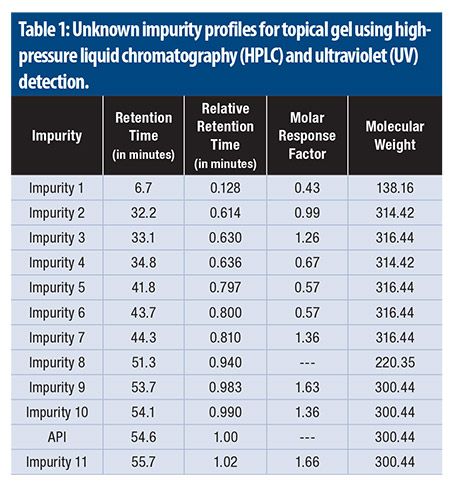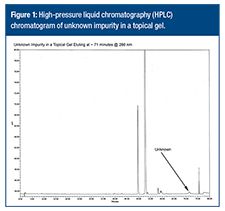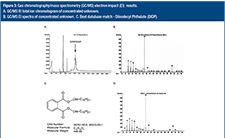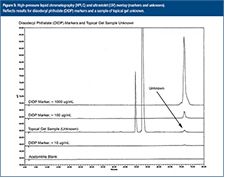Identifying the Structure of an Unknown Impurity in a Topical Gel
This case study highlights analytical instrumentation and techniques that were used to identify an unknown impurity detected during routine release testing of a topical gel drug product.
LIGHTPOET - STOCK.ADOBE.COM

It is not uncommon for pharmaceutical analytical chemists to observe unknown impurities during routine drug product testing using general chromatographic methods such as high-pressure liquid chromatography/ultraviolet or gas chromatography/flame ionization detection. Discovery of an unknown impurity triggers an investigation, along with a shift in priorities from routine to more specific specialized testing in order to be able to answer key questions about the impurity. This case study highlights analytical instrumentation and techniques that were used to identify an unknown impurity detected during routine release testing of a topical gel drug product.
Impurities in pharmaceutical products are defined as “substances in the product that are not part of the API itself or the excipients that are used to manufacture the drug product” (1). These impurities are unwanted chemical entities that remain with the API or finished drug product and may develop during manufacturing or upon storage.
An impurity can be inorganic or organic. In some cases, impurities can be residual traces of solvents that are used in synthesis or manufacturing. During routine drug product testing using general chromatographic methods such as high-pressure liquid chromatography/ultraviolet (HPLC/UV) or gas chromatography/flame ionization detection (GC/FID), discovering an unknown impurity triggers investigations and specialized testing in order to answer several basic questions about the unknown, including:
- What is it?
- Is it toxic?
- How much of it is present?
- Where is it coming from?
Answering these questions can be difficult without access to specialized instrumentation and analytical techniques that can provide structural information about the unknown, allowing a useful toxicological assessment to be made.
Classifying impurities
The impurity may be classified either as a degradation product resulting from chemical reaction of the API during manufacturing and storage, or as a foreign substance that was introduced into the product by contamination or adulteration. Classification of impurities permits the development of adequate control measures to minimize unwanted impurities in the final product. It is important to note that the presence of an impurity, in and of itself, is not necessarily problematic. The introduction of trace levels of impurities is inevitable during the manufacturing or storage of pharmaceutical products.
In fact, scientists expect impurities to be present, hence the requirement that any and all of them be identified and controlled and their presence and concentrations monitored. In many cases, the presence of an impurity may not pose any safety, quality, or efficacy issues for the drug product. In theory, however, the presence of any impurity could influence the efficacy and safety of the finished product. At the very least, impurities confer no therapeutic benefit. In the worst case, they can be toxic. Several authorities, including the International Council for Harmonization (ICH) and FDA, regulate impurity levels in all pharmaceutical products.
Ensuring the purity of an API or finished drug product requires identifying, quantifying, and controlling any impurity once it has been observed. An impurity can be controlled by establishing appropriate control methods at all points where they enter or form during the manufacturing process. According to ICH guidelines on impurities in new drug substances and new drug products (1), identification of impurities below the 0.1% level is not necessary unless the potential impurities are expected to be unusually potent or toxic.
Materials and methods
This case study used the following analytical instrumentation and techniques to identify an unknown impurity that was detected during routine release testing of a topical gel drug product. The impurity was detected by a validated HPLC/UV method with a known impurity profile (Table I) and was out of specification for the product. The following analytical methods were used:
- Liquid chromatography–mass spectrometry/quadrupole time-of-flight (LC/MS/Q-TOF)
- Gas chromatography mass spectrometry / electron impact mass spectrometry (GC/MS EI/MS)
- Fraction collection
- Infrared spectroscopy.
Table 1: Unknown impurity profiles for topical gel using high-pressure liquid chromatography (HPLC) and ultraviolet (UV) detection.

Results and discussion
CLICK IMAGE TO ENLARGE Figure 1: High-pressure liquid chromatography (HPLC) chromatogram of unknown impurity in a topical gel.

After detecting an unknown impurity during routine release testing, a pharmaceutical company requested that investigational testing be performed on its topical gel drug product to identify the impurity and determine whether it was an API degradation product, a process impurity, or a contaminant that had been introduced during the manufacturing process.
The HPLC/UV chromatographic impurity profile of the topical gel release lot is shown in Figure 1. When comparing the known impurity profile (Table I) to the HPLC/UV chromatogram (Figure 1), scientists observed that a single unknown impurity eluted past Impurity 11 (55.7 min.) at approximately 71 minutes. Other chromatographic peaks that were observed eluting after the unknown itself were considered evidence of impurities from solvents that were used to prepare the sample for HPLC testing and considered to be blank-related.
Outlining the process
CLICK IMAGE TO ENLARGE Figure 2: HPLC Spectra. HPLC is high-pressure liquid chromatography, LC is liquid chromatography, MS is mass spectroscopy, and EI is electron impact. A. LC/MS +EI product ion scan of unknown in a topical gel eluting at approximately 71 minutes. B. LC/MS +EI product ion of unknown in a topical gel eluting at approximately 71 minutes (M+1 = 447.3476).

One of the most challenging problems encountered is the identification of unknowns at trace levels in pharmaceutical drug products. This is due mainly to the significant differences in detection limits for each analytical technique that is used to confirm unknown impurities. In this case, the first step in identifying the unknown impurity was testing the drug product by LC/MS using Q-TOF detection. This method provides key information about the identity of the unknown by generating highly accurate mass data. Having highly accurate mass information for the unknown significantly reduces the number of possible molecular formulas or compound identities generated by the molecular formula software.
While this testing provides key information about the unknown, it does not always provide positive identification of the unknown, because hundreds of compounds may share the same molecular formula. Additional experimental data are needed to rule out other compounds and eventually identify the unknown. With this impurity, the mass (M+1) of the unknown was determined to be 447.3476 from Q-TOF LC/MS experiments (Figure 2).
Using the unknown’s accurate mass information and the molecular formula generator, the unknown was determined to have the molecular formula C28H46O4. The exact mass calculation for the molecular formula was 446.3396.
Using the exact mass from the Q-TOF LC/MS experiments and the molecular formula, scientists performed a National Institute of Standards and Technology (NIST) database search and identified a total of 88 potentially matching species within the database, with the top search result being diisodecyl phthalate (DIDP) (2).
CLICK IMAGE TO ENLARGE Table II: Conditions used for gas chromatography/mass spectrometry/electron impact (GC/MS/EI) testing.

Knowing the impurity’s exact mass and having a molecular formula from the LC/MS data is invaluable in helping narrow down its identity from hundreds of potential compounds with the same molecular formula. Other analytical techniques must then be used to rule out or confirm the impurity’s structural identity.
One disadvantage of using LC/MS data is that database libraries with searchable mass spectral data do not exist. However, extensive searchable database libraries are available for GC/MS testing. Thus, the next step in identifying the unknown was to test it by GC/MS. Obtaining electron impact (EI) mass spectra of the unknown would allow for positive identification with a database match.
The LC/MS Q-TOF experiments indicated that the unknown was potentially identifiable as diisodecyl phthalate, which is volatile and thermally stable enough to be detected by GC/MS. A potential problem associated with GC/MS testing, however, was the fact that, if the unknown proved not to be DIDP, it might not be sufficiently volatile to be detected by GC/MS.
In addition, if the unknown were not present at a high enough concentration, it would not be possible to obtain electron impact mass spectra of sufficient quality to search against the database library. To enhance the probability of performing a successful GC/MS run, scientists prepared a concentrated sample of the drug product to ensure that the impurity could be adequately detected, since the sensitivity of the various analytical techniques used to confirm identity can vary significantly.
Multiple injections of both dilute and concentrated sample were made onto an HPLC/UV system to generate a chromatographic profile similar to that in Figure 1. The HPLC eluent from multiple injections was collected for approximately one minute on either side of the expected retention time of the impurity. The fractions were combined and further concentrated at least 10,000-fold to ensure adequate sensitivity for detection. Injections of the concentrated solution were made on the GC/MS using the conditions outlined in Table II.
CLICK IMAGE TO ENLARGE Figure 3: Gas chromatography/mass spectrometry (GC/MS) electron impact (EI) results. A. GC/MS EI total ion chromatogram of concentrated unknown. B. GC/MS EI spectra of concentrated unknown. C. Best database match - Diisodecyl Phthalate (DIDP).

GC/MS results (Figure 3) confirmed that concentrated unknown electron impact (EI) mass spectra were consistent with the best database match for DIDP and the exact mass obtained by LC/MS Q-TOF experiments.Scientists used infrared spectroscopy to test the concentrated impurity, and the results further supported the probability of the unknown being DIDP.
Fourier Transform-Infra-Red (FT-IR) spectra of the unknown did not contain spectral elements that contradicted the mass spectroscopy data and were also consistent with NIST reference spectra of diisodecyl phthalate (Figure 4).
As a final confirmation, a known standard of DIDP was prepared as a marker at multiple concentrations to estimate the concentration of unknown observed in the sample. The DIDP markers, along with a sample preparation, were injected using the original HPLC/UV assay conditions (Figure 5).
Evaluation of all the experimental data collected from the investigational experiments demonstrated that the unknown impurity detected in the topical gel drug product during release testing was DIDP (Figure 3c).
CLICK IMAGE TO ENLARGE Figure 4: A comparison of Fourier-Transform-Infra-Red (FT-IR) spectra A and B. A. Concentrated unknown impurity B. National Institute for Standards and Technology (NIST) spectra for diisodecyl phthalate (DIDP).

It should be noted that commercially available DIDP actually is a mixture of two phthalates. The other component is diisononyl phthalate (DINP). DIDP is composed of a complex mixture of branched C9-C11 isomers containing mainly C10 isomers of C28H46O4. Significant amounts of toxicological data for DIDP are available for review (3).
DIDP is one of eight individual phthalate esters that the US Environmental Protection Agency (EPA) has deemed appropriate subjects for developing assessment and management strategies. It is the main plasticizer used for polymers in wire and cable applications. It also is used in anti-corrosion and anti-fouling paints, sealing compounds, and textile inks (4). Major identified sources of DIDP internationally include food and pharmaceutical packaging as well as printing inks (5). DIDP also is used as an additive in the production of plastics to make them more flexible.
CLICK IMAGE TO ENLARGE Figure 5: High-pressure liquid chromatography (HPLC) and ultraviolet (UV) overlay (markers and unknown). Reflects results for diisodecyl phthalate (DIDP) markers and a sample of topical gel unknown.

In this case, the source of the impurity was not definitely determined; however, scientists believe it was unlikely to be a degradation product of the API, since the molecular weight of DIDP is higher than that of the API. Instead, the impurity was most likely a contaminant that resulted when the API or drug product came in contact with a source of plastic that was introduced during the manufacturing process. To date, no other batches of this drug product have contained this impurity.
References
1. ICH, Q3B(R2), Impurities in New Drug Products, 1-12, June 2, 2006.
2. NIST, Chemistry WebBook, NIST Standard Reference Database Number 69 (2017).
3. US Consumer Products Safety Commission (CPSC), Toxicity Review of Diisodecyl Phthalate (DIDP); 1-29, April 07, 2010.
4. EPA, Phthalate Action Plan; 1-16, March 14, 2012.
5. The Minister of the Environment and the Minister of Health Canada, State of the Science Report (SOS), Long-chain Phthalate Esters DIDP and DUP; 1-144, August 2015.
Article Details
Pharmaceutical Technology
Vol. 44, No. 4
April 2020
Pages: 44-49
Citation
When referring to this article, please cite J. Neal et al, "Identifying the Structure of an Unknown Impurity in a Topical Gel," Pharmaceutical Technology 44 (4) 2020.

Drug Solutions Podcast: Applying Appropriate Analytics to Drug Development
March 26th 2024In this episode of the Drug Solutions Podcast, Jan Bekker, Vice President of Business Development, Commercial and Technical Operations at BioCina, discusses the latest analytical tools and their applications in the drug development market.
Legal and Regulatory Perspectives on 3D Printing: Drug Compounding Applications
December 10th 2024This paper explores the legal and regulatory framework around 3D drug printing, particularly for personalized medicine, considering regulatory compliance, business concerns, and intellectual property rights.